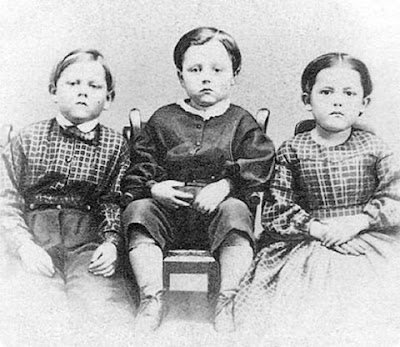
The photo pulled me in. Three little faces, so obviously siblings, looking out from a time long passed.
This photo was found clenched in the hand of a dead soldier at Gettysburg. When this photo was found, a search began to identify the soldier (he had no type of identification on him when he died).
The New York Times is doing a five part series on this story. I am in, can't wait for part two. Check out part one below.
No name — but a soldier brave, he fell.
We shall find her, without a name;
This picture, sometime, will tell whence he came.
— Emily Latimer, “The Unknown”[1]
The soldier’s body was found near the center of Gettysburg with no identification — no regimental numbers on his cap, no corps badge on his jacket, no letters, no diary. Nothing save for an ambrotype (an early type of photograph popular in the late 1850s and 1860s) of three small children clutched in his hand. Within a few days the ambrotype came into the possession of Benjamin Schriver, a tavern keeper in the small town of Graeffenburg, about 13 miles west of Gettysburg. The details of how Schriver came into possession of the ambrotype have been lost to history. But the rest of the story survives, a story in which this photograph of three small children was used for both good and wicked purposes. First, the good.
Four men on their way to Gettysburg were forced to stop at Schriver’s Tavern when their wagon broke down. They heard the tale of the fallen soldier and saw the photograph of the children. One of them, Dr. J. Francis Bourns, a Philadelphia physician on his way to tend to the wounded from the battlefield, was intrigued. He convinced Schriver to give him the photograph so that he might attempt to locate the dead man’s family. Perhaps he was touched by the poignancy of the photograph — three children, all under the age of ten, now without a father. As a life-long bachelor he might have yearned for a wife or family of his own. On the other hand, perhaps he saw it as an opportunity for financial gain.
Dr. Bourns returned to Philadelphia with the ambrotype. He had it copied by several photographers, producing hundreds of inexpensive duplicates in the carte de visite format. The carte de visite photograph, roughly the size of an index card, could be printed in multiple copies, allowing for much quicker mass production of a single photographic image than ever before. Because there was no way of printing photographs in a newspaper, Bourns knew that he might need dozens if not hundreds of cartes de visite to put the image of the three children before the eyes of someone who knew them.
But the story had to be circulated as well, so the photographs were supplemented by a series of newspaper articles, the most prominent of which appeared in The Philadelphia Inquirer on Oct. 19, 1863, a little over three months following the discovery of the ambrotype. It appeared under the heading, “Whose Father Was He?”
After the battle of Gettysburg, a Union soldier was found in a secluded spot on the field, where, wounded, he had laid himself down to die. In his hands, tightly clasped, was an ambrotype containing the portraits of three small children, and upon this picture his eyes, set in death, rested. The last object upon which the dying father looked was the image of his children, and as he silently gazed upon them his soul passed away. How touching! how solemn! What pen can describe the emotions of this patriot-father as he gazed upon these children, so soon to be made orphans! Wounded and alone, the din of battle still sounding in his ears, he lies down to die. His last thoughts and prayers are for his family. He has finished his work on earth; his last battle has been fought; he has freely given his life to his country; and now, while his life’s blood is ebbing, he clasps in his hands the image of his children, and, commending them to the God of the fatherless, rests his last lingering look upon them.
When, after the battle, the dead were being buried, this soldier was thus found. The ambrotype was taken from his embrace, and since been sent to this city for recognition. Nothing else was found upon his person by which he might be identified. His grave has been marked, however, so that if by any means this ambrotype will lead to his recognition he can be disinterred. This picture is now in the possession of Dr. Bourns, No. 1104 Spring Garden [Street], of this city, who can be called upon or addressed in reference to it. The children, two boys and a girl, are, apparently, nine, seven and five years of age, the boys being respectively the oldest and youngest of the three. The youngest boy is sitting in a high chair, and on each side of him are his brother and sister. The eldest boy’s jacket is made from the same material as his sister’s dress. These are the most prominent features of the group. It is earnestly desired that all the papers in the country will draw attention to the discovery of this picture and its attendant circumstances, so that, if possible, the family of the dead hero may come into possession of it. Of what inestimable value it will be to these children, proving, as it does, that the last thoughts of their dying father was for them, and them only.
For those of us used to seeing stories illustrated with photographs, the Philadelphia Inquirer article is fascinating. The absent ambrotype is described: “The children, two boys and a girl, are, apparently, nine, seven, and five years of age, the boys being respectively the oldest and youngest of the three. The youngest boy is sitting in a high chair, and on each side of him are his brother and sister. The eldest boy’s jacket is made from the same material as his sister’s dress.”
The description asks us to think about the details, to imagine them, to pick from among many other details the relevant ones, the ones that can be used to unravel the mystery. The use of “the same material” implies a mother’s hand, or at the very least, a bolt of cloth that was purchased and then used to make clothing for both children. It is evidence — a clue. We are looking for the unseen wife — “. . . we shall find her without a name” — the woman who made the garments out of whole cloth.
Here, a photograph is used to provide a unique identification. Not in the way that might be imagined — someone looking at the ambrotype and saying, “That’s so-and-so . . . .” But by providing a piece of evidence, a context, that could be used to identify the family and the deceased husband and father.
In the traditional detective story, someone asks around: Do you know the identity (or the name) of the people in this photograph? Here, the identification is not made on the basis of recognizing the people from a photograph. But by first “translating” the photograph into words and sentences. The ages of the children were estimated — as it turns out not far from the truth — but the telling details were their respective positions in the photograph, the fact that there were three of them, and the shirt and dress worn by the brother and sister flanking the brother in the middle were similar.
Also, family portraiture was not so commonplace. A family had to go to a photography studio or be visited by an itinerant photographer. The family of the fallen soldier was asked to identify the one picture that was taken. The widow would have enough information to make an identification. Today, we are able to seamlessly integrate words and pictures — captions and photographs — but the Humiston story allows us to see how this was done before there were means to easily put the two together in a newspaper or broadsheet.
And then, a woman in Portville, N.Y., was shown a story about the photograph that appeared in the American Presbyterian. She feared the worst, having not heard from her husband since the battle of Gettysburg. She asked the town postmaster to write to Dr. Bourns on her behalf and request a copy of the ambrotype. When she opened the letter from Philadelphia in late November of 1863, Philinda Humiston knew her husband, Amos Humiston, the father of her three children — Franklin, Alice and Frederick — was dead.
The story of Amos Humiston has been chronicled in a book by Mark H. Dunkelman, “Gettysburg’s Unknown Soldier,”[2] an attempt to recover the “identity” of Amos Humiston from the depredations of history. There were two separate searches more than a century apart, an initial search to identify the fallen soldier, and then a subsequent search to discover something about the man. There is also a series of implicit questions. The first question is: What is his name? The second question: Who is he? Tell me something about Amos Humiston. And then, there is a third question: “Who is he to us? What does he mean to us?” (This is the first of five installments of “Whose Father Was He?” The remaining four parts will be published on consecutive days this week.)
FOOTNOTES[1] “The Unknown” written by Miss E. Latimer for The Orphans’ Homestead (Philadelphia, PA: Bryson & Son, 1867). [2] Mark Dunkelman, Gettysburg’s Unknown Soldier: The Life, Death, and Celebrity of Amos Humiston (Westport, CT: Praeger, 1999). article and photo courtesy of: http://morris.blogs.nytimes.com/
Read more...



































